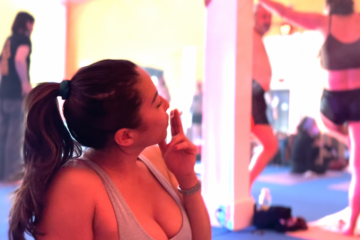How to be Rich in Love: Learn your Attachment Style
Whether you are into being monogamous, polyamorous, “mongogamish”, gay, straight, “greedy” or whatever you identify as, having an awareness of your “attachment style” can significantly help you relate, adjust, and maintain healthy relationships.

Philippe Lewis, Exquisite Love Coaching
It wasn’t until I came across, Philippe Lewis,”Exquisite Love Coach” and Founder of the “Open Relationship Community” board, that I heard about Attachment styles. Understanding attachment style is useful because it offers insight into how you felt and developed in your childhood and clarifies ways that you may be emotionally limited as an adult.
“As we uncover the attachment style we experienced as children and the effects it can have on the ways we relate, we can start to better understand our current behavior,” Lewis says.
What is Your Attachment Style?
Attachment theory is the study of a primitive instinct from childhood that researchers have organized into attachment patterns: 1) secure 2) anxious–preoccupied 3) dismissive–avoidant 4) fearful–avoidant.
Take a quick test to see your attachment style.
Examples of Attachment styles:
1) Secure Attachment : This style of attachment usually results from a history of warm and responsive interactions with their attachment figures. Securely attached people tend to have positive views of themselves and their attachment figures.
2) Anxious-preoccupied (Anxious): People with this style of attachment seek high levels of intimacy, approval, and responsiveness from their partners. They sometimes value intimacy to such an extent that they become overly dependent. Compared to securely attached people, people who are anxious or preoccupied with attachment tend to have less positive views about themselves. They may feel a sense of anxiousness that only recedes when in contact with the attachment figure. People who are anxious or preoccupied with attachment may exhibit high levels of emotional expressiveness, worry, and impulsiveness in their relationships. To alleviate anxiety, they may play games or manipulate your partner to get attention and reassurance by withdrawing, acting out emotionally, not returning calls, provoking jealousy, or by threatening to leave.
3) Dismissive-avoidant (Avoidant): People with this attachment style desire a high level of independence. The desire for independence often appears as an attempt to avoid attachment altogether. They view themselves as self-sufficient and invulnerable to feelings associated with being closely attached to others. They often deny needing close relationships. Some may even view close relationships as relatively unimportant. Not surprisingly, they seek less intimacy with attachment figures, whom they often view less positively than they view themselves. People with a dismissive–avoidant attachment style tend to suppress and hide their feelings, and they tend to deal with rejection by distancing themselves from the sources of rejection (e.g. their attachments). Avoidant people are generally not supportive and responsive when their partners are distressed, and feel uncomfortable turning to others when they need support themselves. They assume that others will behave badly, so they push their lovers away in an effort to create emotional distance. This attempt to deflect or avert deep feelings often backfires. Avoidant people cannot escape thinking about their close relationships no matter how hard they try not to.
4) Fearful-avoidant (Avoidant): People with losses or other trauma, such as sexual abuse may often develop this type of attachment and tend to agree with the following statements: “I am somewhat uncomfortable getting close to others. I want emotionally close relationships, but I find it difficult to trust others completely, or to depend on them. I sometimes worry that I will be hurt if I allow myself to become too close to others.” People with this attachment style have mixed feelings about close relationships. On the one hand, they desire to have emotionally close relationships. On the other hand, they tend to feel uncomfortable with emotional closeness. These mixed feelings are combined with sometimes unconscious, negative views about themselves and their attachments. They commonly view themselves as unworthy of responsiveness from their attachments, and they don’t trust the intentions of their attachments. Similar to the dismissive–avoidant attachment style, people with a fearful–avoidant attachment style seek less intimacy from attachments and frequently suppress and deny their feelings. Because of this, they are much less comfortable expressing affection.
Lewis insists, “People who are insecure will not easily settle in a world that is too secure, they will suspect the aren’t in love anymore or that something is wrong. They will be look for a world that fits their (insecure) internal world. That’s why people with trauma and abuse will find relationships to continue that script…We live our lives emotionally and it affects everything we do.”
What Do Relationship Attachment Matches Look Like?
Secure-Secure – The most stable relationship, but it also has the least emotional tension. But creativity and purpose can become the exciting elements in the relationship.
Secure-Avoidant – A low emotional tension yet very functional relationship, as long as the Avoidants get the space they need.
Secure-Anxious – A fairly stable combination where the secure person stabilizes the anxious one, always reminding the anxious that they are loved.
Anxious-Anxious – The quintessential passionate lovers are a good example of this. Or just a lot of emotions, drama, and worry in the relationship. This volatile match often implodes or explodes faster than all the others.
Avoidant-Avoidant – Another difficult match, as Avoidants will rarely stay in deep committed relationships for long as both will want space. But this may be one of the only match that can withstand long distance relationships or occasional loverships with a minimum of drama… when it doesn’t just fade away.
Anxious-Avoidant – The quintessential tango dance of the anxious and avoidant is the subject of too many stories, epics, and movies, generally starring the anxious passionate woman and the often-bad-boy avoidant low-empathy man. Of course there are many variations, but the story is always the same: the anxious wants more love, and this is great for the avoidant until it’s too much, and then the avoidant runs away to the great distress of the anxious. But then the avoidant feels better in this newfound freedom and comes back to the anxious and asks for forgiveness. The anxious sometimes throws a fit, but the avoidant rises to the occasion and they love each other passionately, until once again we reach a point where it’s too much for the avoidant, and they run away again, and the cycle continues.
How to Overcome our Attachment “Stuff”
Although our patterns of attachment persist throughout our life, it is possible to develop an “Earned Secure Attachment” at any age. What attachment research tells us is that real change becomes possible when we’re willing to look at our history. According to attachment research from Mary Main and Erik Hesse, the biggest predictor of how we’ll be shaped as adults is how much we were able to make sense of and feel the pain of those experiences. It is important to develop a coherent narrative about what happened and the impact it has had on the decisions we may unconsciously have made about how to ‘be’ in the world.
Recognize Your Attachment Styles & Triggers – The more you know about your attachment style, the easier you will be able recognize your triggers. Seek to understand your attachment needs. For example, if you tend to be anxious about your relationships then intimacy and closeness are likely very important to you, even sometimes vital to your happiness, stability and focus. On the other hand, if you are more avoidant in relationships you need and value independence. Understanding and communication your needs is essential when building a secure relationship. But if the other person is also insecure, this emotional balance will be precarious.
Stay “tuned in” with your emotions and actions: When we’re able to stop and notice when we’re triggered, we can make better choices about how we want to act in our relationships. Even though we may be having a strong emotional reaction, we can take some time to calm down, reflect, and choose how we want to act. What actions are in sync with our ultimate goals? Taking this time to pause and evaluate helps us to separate our present from our past and not fall victim to our emotions.
Go to a Relationship Coach or Therapist –. “In secure relationships, there will always be times when you hurt each other — consciously or unconsciously. This means you have to learn to reconnect and repair. Knowing how to apologize and forgive is one way to do this,” says Lewis. Also “If you have an anxious attachment style and you’re already in a relationship with someone with an avoidant attachment style, find a couples therapist or relationship coach who can help both of you become more secure, together. Even if you feel like your relationship is going great, consider taking this step as a pre-emptive strike against trouble. Peer groups — other couples, for examples — and community can also help give the reference points needed to balance things in the relationship, or be a source of support.”
Be readily Forgiving & Relinquish Grudges
“You are going to hurt each other one way or another in relationship,” says Lewis. “It’s what you do about it. It’s important to reconnect in touch, as well as emotionally and intellectually. Conflicts can build healthy attachment and trust if we approach them without fear or a need to punish ourselves or the other person.”
We come to a point where we have to decide if the relationships we are in are healthy and compatible or if what we are doing in our attachment styles is working for us? Do we cut our losses and end those relationships that challenge us to be better versions of ourselves or do we choose to put in the work to overcome some of our deepest triggers? If we can learn where our insecurities come from and make sense of our experiences, maybe it will lead us no longer be ruled by them.










